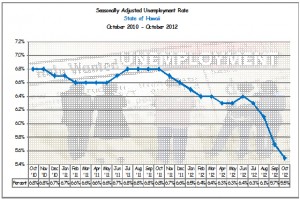 HAWAII: Hawaii’s seasonally adjusted unemployment rate for the month was at 5.5 percent for the first time since November 2008.
HAWAII: Hawaii’s seasonally adjusted unemployment rate for the month was at 5.5 percent for the first time since November 2008.
The Hawai‘i State Department of Labor & Industrial Relations said on Thursday that October’s numbers were down from 5.7 percent in September.
Statewide, there were 606,950 employed and 35,550 unemployed in October, for a total seasonally adjusted labor force of 642,500. Nationally, the seasonally adjusted unemployment rate was 7.9 percent, up from 7.8 percent in September.
Governor Neil Abercrombie also issued a statement on Thursday, saying the news was a clear indication that his administration’s economic strategy is working.
In a media release, the governor stated:
“Hawaii’s improved unemployment rate is another welcome sign that our economy is continuing to recover. Coupled with our state’s strong credit ratings of Aa2/AA/AA and today’s encouraging economic growth forecast by the Department of Business, Economic Development and Tourism, we are seeing clear indications that our administration’s economic strategy is working. To continue this positive momentum, we remain committed to our proven plan of fiscal prudence and investing in state infrastructure and facilities that will continue to stimulate the economy and create employment opportunities for local residents.”
Dept. of Labor & Industrial Relations had these technical notes:
| Seasonal Adjustment The seasonal fluctuations in the number of employed and unemployed persons reflect hiring and layoff patterns that accompany regular events such as the winter holiday season and the summer vacation season. These variations make it difficult to tell whether month-to-month changes in employment and unemployment are due to normal seasonal patterns or to changing economic conditions. To deal with such problems, a statistical technique called seasonal adjustment is used. This technique uses the past history of the series to identify the seasonal movements and to calculate the size and direction of these movements. A seasonal adjustment factor is then developed and applied to the estimates to eliminate the effects of regular seasonal fluctuations on the data. When a statistical series has been seasonally adjusted, data for any month can be more meaningfully compared with data from any other month or with an annual average. Current Population (Household) Survey (CPS) Benchmark Changes to Local Area Unemployment Statistics Data Change to Monthly Employment Estimates For Hawai‘i, this means the transition of statewide and Honolulu MSA areas. State agencies will continue to provide the BLS with information on local events that may impact the estimates, such as strikes or large layoffs/hiring at businesses not covered by the survey and to disseminate and analyze the CES estimates for local data users. BLS feels this change is designed to improve the cost efficiency of the CES program and to reduce the potential bias in state and area estimates. A portion of the cost savings generated by this change is slated to be directed towards raising survey response rates in future years, which will decrease the level of statistical error in the CES estimates. Until then, state analysts feel this change could result in increased month-to-month variability for the industry employment numbers particularly for Hawai‘i’s counties and islands. Seasonally Adjusted Labor Force and Unemployment Estimates for Honolulu |

by Big Island Video News1:35 am
on at
STORY SUMMARY
HAWAII: Hawaii’s seasonally adjusted unemployment rate for the month was at 5.5 percent for the first time since November 2008. The Hawai‘i State Department of Labor & Industrial Relations said on Thursday that October’s numbers were down from 5.7 percent in September. Statewide, there were 606,950 employed and 35,550 unemployed in October, for a total […]